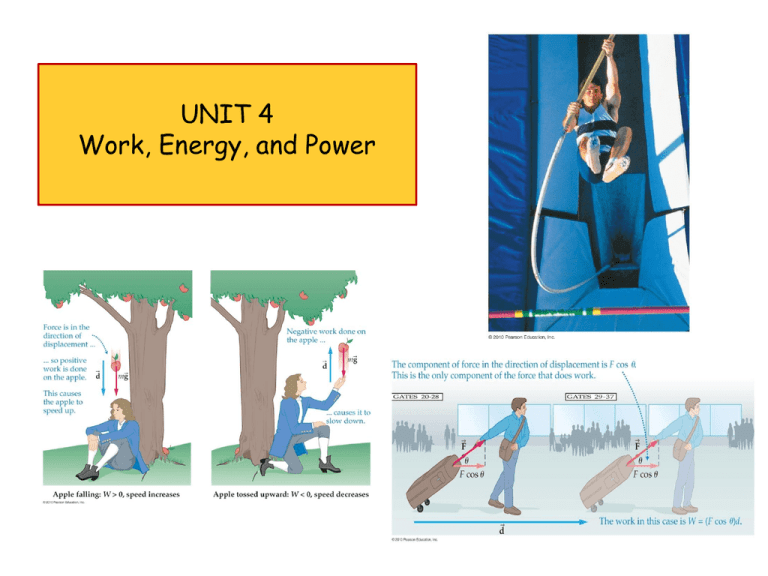
UNIT 4
Work, Energy, and Power
ConcepTest 6.5b Kinetic Energy II
Car #1 has twice the mass of
1) 2 v1 = v2
car #2, but they both have the
2) 2 v1 = v2
same kinetic energy. How do
3) 4 v1 = v2
their speeds compare?
4) v1 = v2
5) 8 v1 = v2
ConcepTest 6.5b Kinetic Energy II
Car #1 has twice the mass of
1) 2 v1 = v2
car #2, but they both have the
2) 2 v1 = v2
same kinetic energy. How do
3) 4 v1 = v2
their speeds compare?
4) v1 = v2
5) 8 v1 = v2
Since the kinetic energy is 1/2 mv2, and the mass of car #1 is
greater, then car #2 must be moving faster. If the ratio of m1/m2
is 2, then the ratio of v2 values must also be 2. This means that
the ratio of v2/v1 must be the square root of 2.
Thursday November 10th
CONSERVATION OF MECHANICAL ENERGY
4
TODAY’S AGENDA
Thursday, November 10
Conservation of Mechanical Energy
Hw: Practice D (All) p172
UPCOMING…
Fri:
More Conservation of Energy:
Bowling Ball Demo
Power
Mon: Problem Quiz 1
Tue: Problems @ the Boards
Chapter 5
Section 3 Conservation of
Energy
Mechanical Energy
• Mechanical energy is the sum of kinetic energy and
all forms of potential energy associated with an object
or group of objects.
ME = KE + ∑PE
• Mechanical energy is often conserved.
MEi = MEf
initial mechanical energy = final mechanical energy
(in the absence of friction)
Chapter menu
Resources
Copyright © by Holt, Rinehart and Winston. All rights reserved.
7
Chapter 5
Section 3 Conservation of
Energy
Sample Problem
Conservation of Mechanical Energy
Starting from rest, a child zooms down a frictionless
slide from an initial height of 3.00 m. What is her
speed at the bottom of the slide? Assume she has a
mass of 25.0 kg.
Chapter menu
Resources
Copyright © by Holt, Rinehart and Winston. All rights reserved.
Chapter 5
Section 3 Conservation of
Energy
Sample Problem, continued
Conservation of Mechanical Energy
1. Define
Given:
h = hi = 3.00 m
m = 25.0 kg
vi = 0.0 m/s
hf = 0 m
Unknown:
vf = ?
Chapter menu
Resources
Copyright © by Holt, Rinehart and Winston. All rights reserved.
Chapter 5
Section 3 Conservation of
Energy
Sample Problem, continued
Conservation of Mechanical Energy
3. Calculate
Substitute values into the equations:
PEg,i = (25.0 kg)(9.81 m/s2)(3.00 m) = 736 J
KEf = (1/2)(25.0 kg)vf2
Now use the calculated quantities to evaluate the
final velocity.
MEi = MEf
PEi + KEi = PEf + KEf
736 J + 0 J = 0 J + (0.500)(25.0 kg)vf2
vf = 7.67 m/s
Chapter menu
Resources
Copyright © by Holt, Rinehart and Winston. All rights reserved.
Chapter 5
Section 3 Conservation of
Energy
Mechanical Energy, continued
•
Mechanical Energy is
not conserved in the
presence of friction.
•
As a sanding block
slides on a piece of
wood, energy (in the
form of heat) is
dissipated into the
block and surface.
Chapter menu
Resources
Copyright © by Holt, Rinehart and Winston. All rights reserved.
Systems and Energy Conservation
Ball dropped from rest falls freely from a height h.
Find its final speed.
mv 2
2
mgh
Wg KE
h
mv 2
mgh
2
v 2gh
v
Energy
Systems and Energy Conservation
A block of mass m compresses a spring (force constant k) a
distance x. When the block is released, find its final speed.
v
m
m
x
kx2
2
Ws KE
kx2 mv 2
2
2
mv 2
2
kx2
v
m
Energy
Systems and Energy Conservation
When released from rest, the block slides to a stop.
Find the distance the block slides.
Friction ()
m
vf = 0
m
k
x
kx2
Ws
2
d
mgd
Ws Wf
kx2
mgd
2
kx2
d
2mg
Energy
END
15







